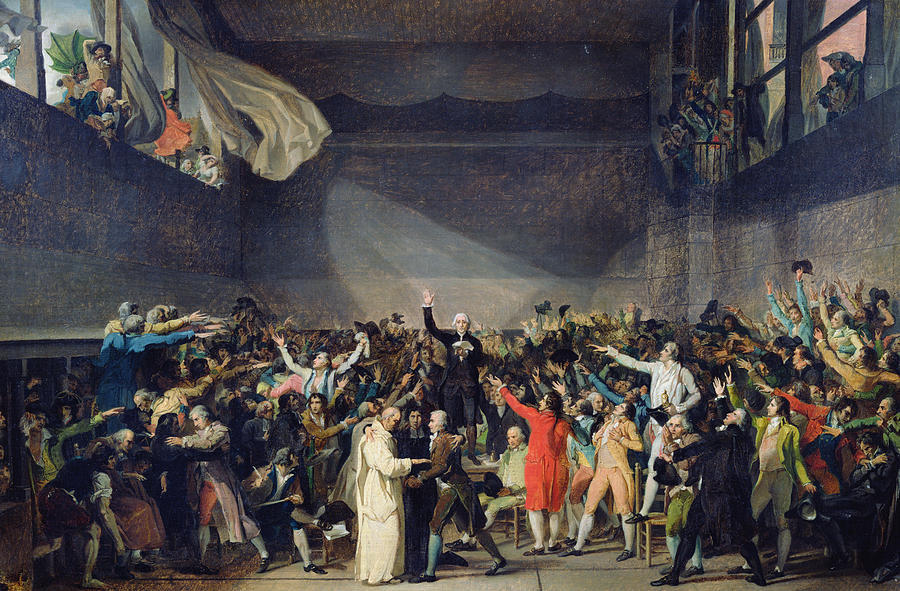Art History Week
Who was Jacques-Louis David?
For those of you unaware of who David might be, he was an incredibly talented pioneer of the Neoclassical period of art during the 18th and 19th centuries. The official painter for Napoleon Bonaparte, David's work for Bonaparte had an extreme influence in the events succeeding the French Revolution in Europe. However, much of his work before and outside of Bonaparte's influence, has tremendous value and significance within its times.

A brief bio:
Jacques-Louis David was born in 1748 to a wealthy family in Paris, France, and died in Brussels, Belgium in 1825. At age 9 his father was killed in a duel, and he was sent off to be taken care of by his uncles, and attend a prestigious school. However David was never a good student, as all he really cared about was drawing, which was not what his family wanted him to do with his life. David ended up in the Royal Academy (which is now essentially The Louvre) at age 18, and further mentored by Joseph-Marie Vien. Inspired by the move from Roccoco art to a more classical approach to art, along with the masterpieces he saw while in Italy (after winning the Prix de Rome), David would later become the pioneer of Neoclassical art. Neoclassicism would stray away from the volatility and artistocratic aspects of the Rococo period of art, and would bring back the classics such as from Roman and Greek history, with a modern twist of perfection and dramatisation.
While in Rome, in 1784, David painted one of his many masterpieces: "Oath of the Horatii"


From his early works it was easy to tell that Jacques-Louis David would be the type of man to rebel against the monarchy, and favor the governments depicted by men such as Rousseau in his "Social Contract". David reflected his political beliefs throughout his entire collection of works in one way or another. Most especially when the French Revolution came around.
From the very beginning, David was an avid supporter of the Revolutionnaries' cause. A friend of Robespierre, he would back the push to oust the French monarchy, and support the move away from aristocratic rule. He is notably famous for his portrayal of Jean-Paul Marat, a close friend of his, who was an extreme radical during the French Revolution - murdered in his bath by Charlotte Corday, a sympathiser to the enemies of the revolution, who blamed Marat for the extreme rebellion occuring in Paris. David was considered the official painter of the Revolution.
David's "Death of Marat", painted in 1793 is an exquisite yet remarkably heart-wrenching depiction of his friend Marat when found dead. His depiction shows Marat holding Charlotte Corday's letter which conveyed false pretenses asking him to meet with her, and the bloody knife that was used by her to stab him in the chest.

The Tennis Court Oath, 1791

Sketch of Marie-Antoinette on her way to the guillotine, 1793:

Napoleon Bonaparte was the one to set David free from his imprisonment due to his ties with the Revolution. Upon Bonaparte's brilliant ascension to power, David quickly became his court painter, effectively putting forth propaganda as leaders would emulate centuries later.
Napoleon crossing the Alps, 1805:

The corronation of Napoleon, 1807:

David was ultimately in exile when the bourbon dynasty returned to France, after Bonaparte's own exile and death. He painted his last great masterpieces, attaching to it the words: "This is the last picture I want to paint, but I want to surpass myself in it. I will put the date of my seventy-five years on it and afterwards I will never again pick up my brush."
Mars being disarmed by Venus and the Three Graces, 1824:

He died a year later.
Early Works:
While in Rome, in 1784, David painted one of his many masterpieces: "Oath of the Horatii"

"The Death of Socrates" followed, in 1787:

From his early works it was easy to tell that Jacques-Louis David would be the type of man to rebel against the monarchy, and favor the governments depicted by men such as Rousseau in his "Social Contract". David reflected his political beliefs throughout his entire collection of works in one way or another. Most especially when the French Revolution came around.
David and the French Revolution
From the very beginning, David was an avid supporter of the Revolutionnaries' cause. A friend of Robespierre, he would back the push to oust the French monarchy, and support the move away from aristocratic rule. He is notably famous for his portrayal of Jean-Paul Marat, a close friend of his, who was an extreme radical during the French Revolution - murdered in his bath by Charlotte Corday, a sympathiser to the enemies of the revolution, who blamed Marat for the extreme rebellion occuring in Paris. David was considered the official painter of the Revolution.
David's "Death of Marat", painted in 1793 is an exquisite yet remarkably heart-wrenching depiction of his friend Marat when found dead. His depiction shows Marat holding Charlotte Corday's letter which conveyed false pretenses asking him to meet with her, and the bloody knife that was used by her to stab him in the chest.

The Tennis Court Oath, 1791

Sketch of Marie-Antoinette on her way to the guillotine, 1793:

David and Napoleon:
Napoleon Bonaparte was the one to set David free from his imprisonment due to his ties with the Revolution. Upon Bonaparte's brilliant ascension to power, David quickly became his court painter, effectively putting forth propaganda as leaders would emulate centuries later.
Napoleon crossing the Alps, 1805:

The corronation of Napoleon, 1807:

David was ultimately in exile when the bourbon dynasty returned to France, after Bonaparte's own exile and death. He painted his last great masterpieces, attaching to it the words: "This is the last picture I want to paint, but I want to surpass myself in it. I will put the date of my seventy-five years on it and afterwards I will never again pick up my brush."
Mars being disarmed by Venus and the Three Graces, 1824:

He died a year later.
If you have any questions about David, Napoleon, the French Revolution, or more specifically: Neoclassical Art, feel free to leave a comment here and I'll be happy to respond.


